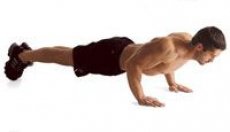Medical expert of the article
New publications
Push-ups for back muscles
Last reviewed: 08.07.2025

All iLive content is medically reviewed or fact checked to ensure as much factual accuracy as possible.
We have strict sourcing guidelines and only link to reputable media sites, academic research institutions and, whenever possible, medically peer reviewed studies. Note that the numbers in parentheses ([1], [2], etc.) are clickable links to these studies.
If you feel that any of our content is inaccurate, out-of-date, or otherwise questionable, please select it and press Ctrl + Enter.

Exercises on the floor
Once forgotten, the push-up has once again climbed to the top of the fitness universe. Here's why this exercise should be part of your workout.
This isn't just an exercise your dad once did. Or your coach. Or your commander in the army. Push-ups have been reborn because they pump up your muscles, strengthen your back, and improve your athletic performance.
Why Push-Ups Are Good for Your Back
Perfect push-up form is the same as perfect posture. And a push-up done incorrectly—with excessive arching in the lower back—is like having very bad posture. If you learn how to do push-ups correctly—and maintain good posture inside and outside the gym—you'll reduce your risk of back pain.
The key to good posture is your pelvis, specifically the ability to properly "abduct" your hips. At the beginning of the crunches, when your abdominal muscles contract, your back is flat on the floor. Keep it there. Note that your lower back should be straight and your stomach should be pulled in. This is the best and safest position for your back.
Tip: Lie on the floor and try a progression of exercises to improve your posture.
- Weeks 1-3: Before you start your workout, do the plank exercise. During the first week, do this exercise 10 times and hold the plank for 5 seconds, during the second week - 4 times for 15 seconds, and during the third week - 1 time for 30 seconds.
- Weeks 4-6: Hold the push-up position for 30 seconds in week 4, then 30 seconds in the knuckle position in week 5. Finally, in week 6, perform slow push-ups, maintaining perfect posture. It should take you 2 seconds to lower yourself, then hold the bottom position for 2 seconds, and rise up in 2 seconds. Do 10 reps at this pace.
Every time you feel your back start to sag forward, pull your stomach in and straighten your back. The more you focus on your posture, the better your results will be.
Fitness trainers use push-ups in many movements. Experiment with a few exercises. Try chain push-ups, 3 sets of 8-10 reps once a week; plyometric push-ups, 3-5 sets of 4-6 reps, once a week on an alternate day; and twist push-ups, 1-2 sets of 4-6 reps on each side.
3 ways to increase the load:
- Place a backpack with something heavy on your shoulders. Make sure the weight is near your shoulders and not on your lower back.
- Find a partner who will place a weight plate on the middle of your back.
- Put on a weighted vest. The 1-pound weights are soft and flexible, so you won't feel too heavy.


 [
[